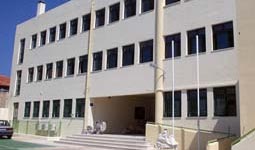BELL RINGS FOR NEW EUROPEAN SCHOOL
The newly-established School for European Education, an institution for children of parents from the European Union, has opened its doors in a picturesque location in Heraklion – nestled quietly between the Agia Triada church and Old Market behind the Old Port.
 The building is impressive and, importantly for a school, security is tight: two entrances, both with gates locked. A visitor must wait for one of the teachers before being allowed on the school grounds.
The building is impressive and, importantly for a school, security is tight: two entrances, both with gates locked. A visitor must wait for one of the teachers before being allowed on the school grounds.
Georgios Papayiannis, the principal, is a graduate of Boston University , in the U. S. , and is a former staff member of the original European School in Brussels . He made it immediately clear that he strongly believes “in the future of the school so that children can become European citizens”.
Mr. Papayiannis, originally from Alexandroupolis, has come from probably the most northerly city in Greece , to the furthest south, and is “looking forward” to embarking on his newly appointed position as principal of this important new school.
He explained that the system of European Schools was set up in response to the multi-lingual European employees of ENJSA, The European Organism for the Safety of Networks and Information, who required schooling for their children in their mother tongue.
As well as providing education for the children of ENJSA employees, the school is also inviting applications from parents from the EU with children up to the age of 8 (up to Grade 3). Next year the school intends to offer a Grade 4 class, as Grade 3 pupils move up a year, and continue adding Grades, until the school eventually offers a full range of classes from nursery to secondary education.
The children at the school study core subjects, for example, language and mathematics, in their own language. For other subjects, such as culture and history lessons, they are co-taught bilingually. In these bi-lingual sessions the pupils are given the opportunity to converse and learn about each others culture, share thoughts and opinions and, of course, develop language skills. In this way they are gaining a wide range of experience and knowledge not usually available in other schools.
Mr. Papayiannis went on to say that the school, although built with money from the EU, is funded by the Greek government, and not Brussels , where the largest school of this type is located. It follows the European Schools’ method of interdisciplinary teaching. All the teachers are highly qualified, bi-lingual and have served in the public school system at some point in their career.
The school building is spacious and impressive; the corridors are spacious and airy. There are already plans for expansion, explained Mr. Papanyiannis, which include high-tech teleconferencing facilities enabling pupils in Heraklion to work alongside pupils at the sister school in Brussels. An official school website is currently being designed and, when completed, the public will have an opportunity to explore all aspects of the new school.
Although classes have begun, Mr. Papayiannis said he is looking forward to the “official” opening and launch of the school due to take place in two months time.
At present, of the 90 pupils enrolled at the school, 10 are English- speaking. The school is actively seeking enrollment from the English-speaking EU community in and around Heraklion, and at present can only accept children up to the age of 8 (Grade 3).
More information about enrolment at the European School for Education in Heraklion can be obtained by calling 2810 301782 or at their website: https://seeh.eu/en/
By Kate Roberts